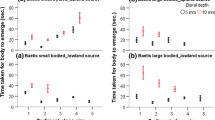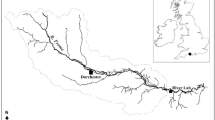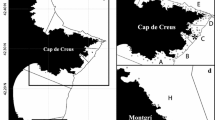Abstract
In many coastal regions, the disposal of dredged material constitutes the largest (albeit often localised) anthropogenic disturbance to the seabed. Impacts can be minimised by reducing the amount of sediment overburden on the bed at any one time allowing short-term recovery to proceed via the vertical migration of resident species. However, there is currently a limited understanding of the ability of such species to successfully vertically migrate. This study presents the findings of a field experiment to investigate the vertical migratory capability of temperate macroinvertebrate species following the placement of simulated dredged material. The relationships between vertical migration success with sediment characteristics (organic carbon and sand content) and placement depth were explicitly examined. While the polychaete worms Tharyx sp. A. and Streblospio shrubsolii showed poor vertical migration with only 6 cm of sediment overburden, the oligochaete Tubificoides benedii showed some recovery while the gastropod mollusc Hydrobia ulvae exhibited good migratory success, even with 16 cm of sediment overburden. While increases in sand content from 16% to 38% had no noticeable effect on vertical migration, increased sediment organic content from 0.8% to 3.3% detrimentally affected vertical migratory activity. The results support the theory that species’ survival following sediment burial is trophic group-related. The relevance of these findings with respect to dredged material disposal management is discussed.
Similar content being viewed by others
References
Anon (2003). Characterisation of dredged material at source: Organic matter and particle size (pp. 80–83). Aquatic Environment Monitoring Report No. 54, CEFAS, Lowestoft, UK.
Bolam, S. G. (2003). Vertical migration of macrofauna following the intertidal placement of dredged material: An in situ experiment (pp. 49–59). Amsterdam: CEDA Dredging Days.
Bolam, S. G., & Fernandes, T. F. (2002). Dense aggregations of tube-building polychaetes: Response to small-scale disturbances. Journal of Experimental Marine Biology and Ecology, 269, 197–222.
Bolam, S. G., & Rees, H. (2003). Minimising the impacts of maintenance dredged material disposal in the coastal environment: A habitat approach. Environmental Management, 32, 171–188.
Bolam, S. G., & Whomersley, P. (2005). Development of macrofaunal communities on dredged material used for mudflat enhancement: A comparison of three beneficial use schemes after one year. Marine Pollution Bulletin, 50, 40–47.
Bolam, S. G., Fernandes, T. F., & Huxham, M. (2002). Diversity, biomass and ecosystem processes in the marine benthos. Ecological Monographs, 72(4), 599–615.
Bolam, S. G., Waldock, R., & Paipai, E. (2003a). Beneficial use of fine-grained dredged material: Identifying novel placement techniques. Dredging and Port Construction, January, 2003 (pp. 26–29). Redhill: Central Dredging Association and Eastern Dredging Association.
Bolam, S. G., Rees, H., Murray, L. A., & Waldock, R. (2003b). Intertidal placement of fine-grained dredged material. In Solving coastal conundrums, proceedings of the 28th international conference of coastal engineers, Cardiff, July 2002. USA: American Society of Coastal Engineers.
Bolam, S. G., Schratzberger, M., & Whomersley, P. (2004). Macrofaunal recolonization in intertidal mudflats: The effect of organic content and particle size. Journal of Experimental Marine Biology and Ecology, 306, 157–180.
Bolam, S. G., Rees, H. L., Somerfield, P., Smith, R., Clarke, K. R., Warwick, R. M., et al. (2006). Ecological consequences of dredged material disposal in the marine environment: A holistic assessment of activities around the England and Wales coastline. Marine Pollution Bulletin, 52, 415–426.
Bolam, S. G., Barry, J., Schratzberger, M., Whomersley, P., & Dearnaley, M. (2010). Macrofaunal recolonisation following the intertidal placement of fine-grained dredged material. Environmental Monitoring and Assessment, 168, 499–510.
Bijkerk, R. (1988). De effecten op bodemdieren van een verhoogde sedimentatie als gevolg van baggerwerkzaamheden (pp. 1–72). Groningen: RDD Aquatic Ecosystems.
Chandrasekara, W. U., & Frid, C. J. (1998). A laboratory assessment of the survival and vertical movement of two epibenthic gastropod species, Hydrobia ulvae (Pennant) and Littorina littorea (Linnaeus), after burial in sediment. Journal of Experimental Marine Biology and Ecology, 221, 191–207.
Ehrlich, P. R., & Wilson, E. O. (1991). Biodiversity studies: Science and policy. Science, 25, 758–762.
Engler, R., Saunders, L., & Wright, T. (1991). Environmental effects of aquatic disposal of dredged material. The Environmental Professional, 13, 317–325.
Essink, K. (1999). Ecological effects of dumping of dredged sediments: Options for management. Journal of Coastal Conservation, 5, 69–80.
Gee, J. M., Warwick, R. M., Schanning, M., Berge, J. A., & Ambrose, W. G. (1985). Effects of organic enrichment on meiofaunal abundance and community structure in sublittoral soft sediments. Journal of Experimental Marine Biology and Ecology, 91, 247–262.
Hall, S. J. (1994). Physical disturbance and marine benthic communities: Life in unconsolidated sediments. Oceanography and Marine Biology: An Annual Review, 32, 179–239.
Harvey, M., Gauthier, D., & Munro, J. (1998). Temporal changes in the composition and abundance of the macro-benthic invertebrate communities at dredged material disposal sites in the Anse a Beaufils, Baie Des Chaleurs, Eastern Canada. Marine Pollution Bulletin, 36, 41–55.
Hinchey, E. K., Schaffner, L. C., Hoar, C. C., Bogt, B. W., & Batte, L. P. (2006). Responses of estuarine benthic invertebrates to sediment burial: The importance of mobility and adaptation. Hydrobiologia, 556, 85–98.
Maurer, D., Keck, R. T., Tinsman, J. C., Leathem, W. A., Wethe, C. A., Huntzinger, M. et al. (1978). Vertical migration of benthos in simulated dredged material overburdens (Vol. 1, pp. 1–97). Marine benthos. DMRP Technical report D-78–35. Vicksburg: Waterways Experimental Station.
Maurer, D., Keck, R. T., Tinsman, J. C., & Leathem, W. A. (1981). Vertical migration and mortality of benthos in dredged material - Part I: Mollusca. Marine Environmental Research, 4, 299–319.
Maurer, D., Keck, R. T., Tinsman, J. C., & Leathem, W. A. (1982). Vertical migration and mortality of benthos in dredged material: Part III - Polychaeta. Marine Environmental Research, 6, 49–68.
Maurer, D., Church, T. M., Lord, C., & Wethe, C. (1985). Marine benthos in relation to pore water chemistry and sediment geochemistry of simulated dredged material. International Revue gesamten Hydrobiologie, 70, 369–377.
Miller, D. C., Muir, C. L., & Dauser, O. A. (2002). Detrimental effects of sedimentation on marine benthos: What can be learned from natural processes and rates? Ecological Engineering, 19, 211–232.
Morton, J. W. (1977). Ecological effect of dredging and dredge spoil disposal: A literature review (pp. 1–30). Technical Papers of the U.S. Fish and Wildlife Service 94:33S., Washington.
Murray, L. A. (1994). Progress in England and Wales on the development of beneficial uses of dredged material. In Proceedings of the 2nd international conference, Dredging’94, 13–16th November 1994, Lake Buena Vista, Florida, USA (pp. 644–653). Waterways Committee of the Waterways, Port, Coastal and Ocean Division/ASCE.
National Rivers Authority (1991). The quality of rivers, canals and estuaries in England and Wales. Report of the 1990 survey. National Rivers Authority, Water Quality Series 4, 64 pp.
Nichols, J. A., Rowe, G. T., Clifford, C. H., & Young, R. A. (1978). In situ experiments on the burial of marine invertebrates. Journal of Sedimentary Petrology, 48, 419–425.
O’Connor, T. P. (1999). A wider look at the risk of ocean disposal of dredged material. Marine Pollution Bulletin, 38, 760–761.
OSPAR (1998). The Convention for the Protection of the Marine Environment of the North-East Atlantic. www.ospar.org
Pfitzenmeyer, H. T., & Drobeck, K. G. (1967). Some factors influencing reburrowing activity of soft-shell clam, Mya arenaria. Chesapeake Science, 8, 193–199.
Powilleit, M., Kleine, J., & Leuchs, H. (2006). Impacts of experimental dredged material disposal on a shallow, sublittoral macrofauna community in Mecklenburg Bay (western Baltic Sea). Marine Pollution Bulletin, 52, 386–396.
Raffaelli, D. G., & Moller, H. (2000). Manipulative field experiments in animal ecology: Do they promise more than they can deliver? Advances in Ecological Research, 30, 299–338.
Richardson, M. D., Carey, A. G., & Colgate, W. A. (1977). Aquatic disposal field investigation, Columbia River disposal, Oregon (pp. 1–79). Corvallis: Corvallis School of Oceanography, Oregon State University.
Roberts, R. D., Gregory, M. R., & Foster, B. A. (1998). Developing an efficient macrofauna monitoring index from an impact study—a dredge spoil example. Marine Pollution Bulletin, 36, 231–235.
Schratzberger, M., & Warwick, R. M. (1998). Effects of the intensity and frequency of organic enrichment on two estuarine nematode assemblages. Marine Ecology Progress Series, 164, 83–94.
Shulenberger, E. (1970). Responses of Gemma gemma to a catastrophic burial. The Veliger, 13, 163–170.
Theede, H. (1973). Comparative studies on the influence of oxygen deficiency and hydrogen sulphide on marine bottom invertebrates. Netherlands Journal of Sea Research, 7, 244–252.
Thrush, S. F., Cummings, V. J., Dayton, P. K., Ford, R., Grant, J., Hewitt, J. E. et al. (1997). Matching the outcome of small-scale density manipulation experiments with larger scale patterns an example of bivalve adult/juvenile interactions. Journal of Experimental Marine Biology and Ecology, 216, 153–169.
Turk, T. R., & Risk, M. J. (1981). Effect of sedimentation on infaunal invertebrate populations of Cobequid Bay, Bay of Fundy. Canadian Journal of Fisheries and Aquatic Science, 38, 642–648.
Valdes-Cogliano, S., Hinckley, D., & Holm, H. W. (1989). Ecological effects of dredged materials disposal (pp. 136–138) Oceans’89: The global ocean. Washington: Marine Technology Society.
Vogt, C., & Walls, B. (1991). Environmental effects of dredged material disposal—EPA concerns and regulations. In Proceedings of the 24th Annual Dredging Seminar 1991 (pp. 71–80). Texas Engineering Experimental Station, Texas.
Waldock, R., Rees, H. L., Matthiessen, P., & Pendle, M. A. (1999). Surveys of the benthic infauna of the Crouch Estuary (UK) in relation to TBT contamination. Journal of the Marine Biological Association of the UK, 79, 225–232.
Whomersley, P., Huxham, M., Bolam, S. G., Schratzberger, M., Augley, J., & Ridland, D. (2010). Response of intertidal macrofauna to multiple disturbance types and intensities—an experimental approach. Marine Environmental Research, 69, 297–308. doi:10.1016/j.marenvres.2009.12.001
Widdicombe, S., & Austen, M. C. (2001). The interaction between physical disturbance and organic enrichment: An important element in structuring benthic communities. Limnology and Oceanography, 46, 1720–1733.
Wilber, D. H., Clarke, D. G., & Rees, S. I. (2007). Responses of benthic macroinvertebrates to thin-layer disposal of dredged material in Mississippi Sound, USA. Marine Pollution Bulletin, 54, 42–52.
Zar, J. H. (1984). Biostatistical analysis 2nd edn. New Jersey: Prentice Hall.
Author information
Authors and Affiliations
Corresponding author
Rights and permissions
About this article
Cite this article
Bolam, S.G. Burial survival of benthic macrofauna following deposition of simulated dredged material. Environ Monit Assess 181, 13–27 (2011). https://doi.org/10.1007/s10661-010-1809-5
Received:
Accepted:
Published:
Issue Date:
DOI: https://doi.org/10.1007/s10661-010-1809-5




